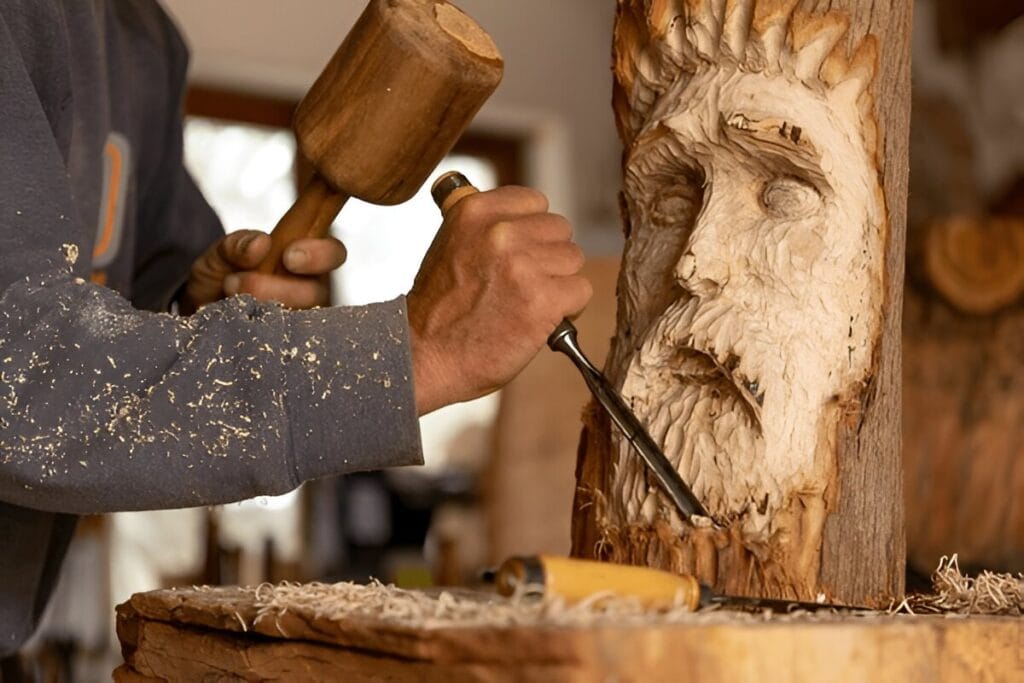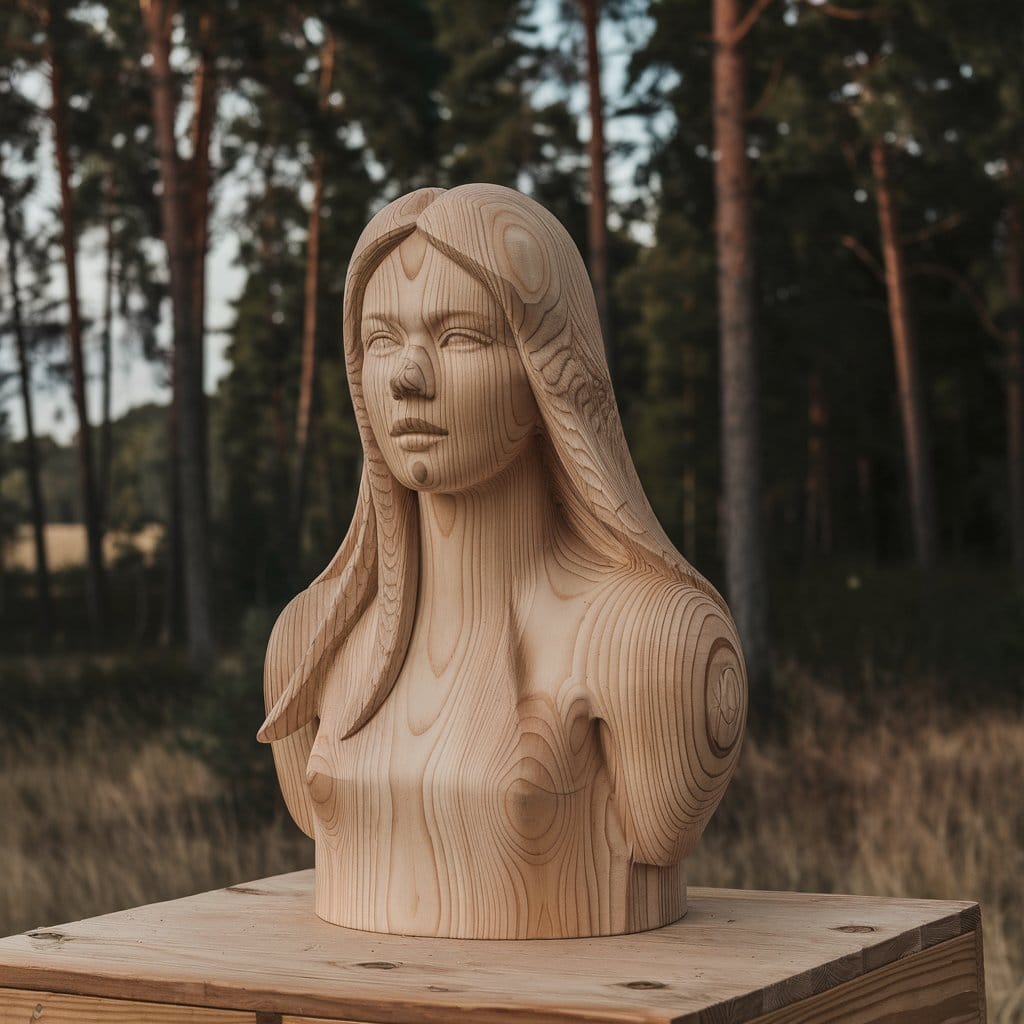
This article will look into the fascinating nature of the wood arts. In this area, stunning designs are combined with the highest standards of craftsmanship. Begin your journey today to glance at the incredible sculptures created out of wooden pieces. Learn about the rich story of the art form, the exact process, and the profound significance of these stunning sculptures.
Prepare to be amazed by the talent of talented artists. They work with wood and transform it into breathtaking art.
They inspire admiration and awe. Prepare yourself to be swept away by the breathtaking beauty of wood sculptures where every curve and aspect tells a tale. Be prepared to be awestruck by artwork that stands out from all other art.
Unveiling Wood Art: A Closer Look at Sculptures

Wood sculptures add life to ordinary materials through chiseling and precise carving, transforming them into stunning artwork.
If we look into the intriguing nature of the wood arts, we uncover its rich history and distinctive techniques. This art form from the past displays timeless beauty. Prepare to be mesmerized by the beauty of wood sculptures while we look into the mysteries behind these masterpieces.
The History of Wood Sculptures
Wood has a rich history that dates back to early civilizations. It was among the first materials utilized for art. Wood has played a significant part in contemporary art worldwide. This is evident in the intricate carvings on Egyptian Sarcophagi and the gorgeous patterns found on Buddhist artifacts from Asia.
Over the years, wood carved sculptures have honored gods and ancestral ancestors and represented cultural traditions and values. In the Middle Ages, wooden sculptures featured cathedrals and churches in Europe. They told stories of religion with stunning artwork.
The Renaissance brought back interest in beauty and classical art, leading to a more intense emphasis on the natural aspects of carving wood. Wood sculptures evolved into symbols of religion and depictions of emotions and human experiences. Their distinctive shapes convey the beauty and profundity of the universe.
As time passed, Wood sculptors explored different techniques and designs, challenging the boundaries of what they could create using wood.
Wood sculptures have changed from traditional carvings of symbolic nature and abstract art. These modifications challenge how people consider art.
The Characteristics of Wood as a Medium
Wood is a great sculpture material with distinctive characteristics that differentiate it from other materials. The most attractive characteristics of wood are its organic warmth and natural look, which give the sculpture the feeling of living and vitality. Wood species’ grain colors, textures, and colors offer endless possibilities for creating visual interest and depth in wood-based art.
Wood is also an incredibly multifaceted, allowing artists to experiment with various carving techniques. These include relief, circular, and chip carving techniques. Wood’s versatility is ideal for precise details and large-scale designs.
Additionally, wood’s ability to endure intricate shapes and provide sturdy structure contributes to wood artwork’s lasting beauty and endurance. This guarantees that these works can be enjoyed for a long time.
The Different Techniques of Wood Sculpting
Wood sculpting is a multifaceted art form incorporating various techniques artisans have developed. The most well-known method is relief carving, which uses flat lumber to create depth and dimension. This technique allows intricate features to be cut precisely through the wood, creating beautiful designs that seem real.
Another wood carving technique is chip-carving, which involves removing small pieces of wood to create patterns and designs. This method requires patience and skill; every cut must be carefully planned to produce the desired outcome. Chip carving is known for its geometrical accuracy and, if done correctly, the ability to create amazing visual effects.
Artists can also create carvings on the ring when the 3D-like sculpture is constructed by removing a chunk of wood. This technique requires a keen awareness of form and proportion, and the artist needs to consider what the sculpture will look like from various angles. Round carving creates dynamic and interactive art pieces that attract attention from every angle.
Famous Wood Sculptors Throughout History
Various talented artists have made an indelible impression on humanity’s time through their stunning wood sculptures. One of these artists is Grinling Gibbons, a renowned English artist known for his intricate, realistic wood carvings that graced many famous buildings in the last quarter of the 17th century. His extraordinary work and emphasis on details set the benchmark for the future new generation of sculptures made from wood.
Another well-known persona in wood sculpture is Ernst Barlach, a German artist known for his vivid and expressive wood sculptures. Barlach’s works often addressed human suffering and spirituality while making sense of emotion through a simplicity that conveyed its profoundness. His ability to inject life into his woodwork has inspired artists across the globe.
James Surls has emerged as a leading expert in woodwork, acknowledged for his large organic designs that seamlessly blend with the natural world. Surls’s dynamic pieces often depict themes of growth and change and invite the viewer to contemplate the interdependence between humanity and the natural world. Through his work, Surls reminds us of the beauty and strength of wood and living things.
Types of Wood Used in Sculpting
The choice of wood for the sculpture is essential in determining the sculpture’s aesthetics and the quality of the structure. Artists worldwide utilize a variety of types of wood, each offering distinct characteristics and difficulties.
For example, the oak variety is known for its strength, making it an excellent option for large-scale sculptures that require long-lasting durability. However, the delicate wood grain patterns provide a refined look to more intricate and elaborate sculptures. With its deep reddish-brown shade and silky texture, Mahogany is the most preferred choice for artists due to its beautiful design and quality.
Cedar, well-known for its smell and durability to decay, is often utilized in outdoor sculptures due to its ability to withstand the elements. In addition, exotic woods like teak and ebony are sought after due to their unique patterns and colors, which elevate the sculpture to a more excellent quality standard. The diversity of woods lets artists explore a variety of styles, colors, and even finishes, allowing them to bring their creative ideas to life in an engaging way.
The wide variety of wood lets you discover the many possibilities for wood sculpture and an endless array of options. Each species has its own story and distinctive characteristics to the art and encourages sculptors to push boundaries and create epic sculptures that attract audiences. When artists are drawn by the beauty and versatility of various wood species, they can respect the past and develop new methods that lead to various artistic creations with timeless appeal.
Contemporary Trends in Wood Sculptures
Modern trends in Wood Sculptures: Contemporary artists redefine boundaries and challenge traditional methods in wood sculptures. One notable trend is the mixing of wood with other materials, including metal, glass, or recycled materials, resulting in distinct pieces that challenge the established standards of artistic excellence.
Another trend is the increasing emphasis on sustainability, eco-sustainability, and similar issues in wood sculpture. Artists increasingly use recycled or responsibly sourced timber to create their art, highlighting the significance of the environment in their art creation. Moving towards sustainable practices creates more sustainable futures and adds extra importance to the work.
There is also an increasing interest in incorporating technology into wood into art. From intricate designs created by lasers or lasers to interactivity, electronic art artists are using the latest technology to give fresh life to the traditional technique of carving wood. Using technology, wood sculpture artists can open endless possibilities and create striking artworks that appeal to modern-day people.
The Role of Wood Sculptures in Society
Wood sculptures are vital to the world of art, serving as tools for expression and telling tales. With intricate designs and key representations, wooden works of art provide an understanding of different communities’ beliefs, values, and customs. They often tell stories that unite people from various locations and periods, creating a sense of shared heritage and unity.
Additionally, wood sculptures assist with conserving old crafts and artisanship techniques within societies. They display the expertise of sculptors as they manipulate wood into distinctive designs. They preserve traditional cultural values and encourage the continuing use of conventional techniques. That’s why wood sculptures protect the past, keeping traditional art forms for future generations to enjoy and understand.
Wood sculptures can stir emotions, spark conversations, and inspire viewers to think. Artwork can stimulate curiosity and reflection when placed in public spaces or private collections. When encountering the art of wood, visitors are encouraged to contemplate beauty, spirituality, nature, and human experiences, adding value and delight.
How to Care for Wood Art Pieces
Proper maintenance and care are crucial to preserving the appearance and durability of wood-based artworks. To maintain the strength of your wooden artwork, keep it away from direct sunlight and near the heat source to avoid discoloration or warping. Make sure you clean your artwork regularly with a soft, dry cloth to keep dirt from accumulating and maintain the original shine.
Additionally, it is vital to ensure the humidity levels in the area where your artwork is displayed. Variations in humidity could cause wooden objects to expand or shrink, leading to cracks and damage. Utilizing a humidifier or dehumidifier could help keep the surrounding environment stable and protect your wooden objects for an extended period.
Applying a premium polish made specially for wooden art could be beneficial. This can enhance the sculpture’s aesthetics and protect it from dust and water. By following these easy-care tips, the wood sculpture will be a lasting treasure that adds elegance and pleasure to your house.
Notable Wood Sculptures Around the World
Some noteworthy sculptures in striking wood art from around the world have stood the test of time and show human imagination and talent. One of these works is “The Angel” by Gustav Vigeland, which is set in Oslo, Norway. It captures ethereal qualities and grace through intricate carving techniques on wood. The calm and serene look creates an atmosphere of peace and wonder for the visitors.
Explore the world to see the magnificent “Ngatiawa River Monastery Doors,” crafted by artist Kerry Strongman in New Zealand. The substantial wood doors tell a dramatic story of awakening to the spiritual and rebirth. Each exquisite detail reflects harmony with nature and the spiritual. These works’ sheer size and depth enthrall admirers with the profound link between art and spirituality.
On the eastern horizon lies Japan’s renowned “Great Buddha of Kamakura,” an impressive wooden figure depicting wisdom and peace. Carved in the 13th century, this majestic statue exudes an aura of unending beauty and resilience and reflects the eternal humanness of humankind across all generations. The sculpture’s calm visage symbolizes the power of hope and perseverance in an ever-changing world.
The Future of Wood Sculpting
Looking at the future of carving and wood, we can envision a future filled with imagination and creativity. Innovative technologies, such as 3-D printing, robotics, and even carving, are transforming how artists utilize wood. Advancements in technology enable artists to push the boundaries of traditional techniques and create unique pieces previously thought impossible.
In addition, there is an increase in consciousness of sustainability in the art world, which leads to a rise in the need for eco-friendly methods of wood sculpture. Artists consider recycled wood and sustainably produced materials to reduce their environmental footprint while bringing distinct stories to their work. The transition to sustainability benefits the environment while forcing artists to think outside the box and try new techniques.
Collaborations between wood sculptures and other creative disciplines, such as architecture and design, blur the lines between art forms. This multidisciplinary approach enriches the art world and provides new possibilities for innovative projects that blend practicality with aesthetics. The future of carving with wood is bright, offering an intriguing combination of tradition and modernity that will entice people for a long time.
Conclusion
We can see their timeless value and beauty when we finally explore the vast world of wood sculptures. Each beautiful piece of wood carving is an epic story, connecting humans to the world of nature and our imagination in an era that transcends time and space.
Wood transforms into breathtaking artworks by the skilled hand of master craftsmen. These artworks stir emotions, inspire contemplation, and ignite our imagination. We should keep admiring and supporting the gifted artists who bring life back to small pieces of wood and create art that enriches our lives in many ways.


